When planning your meals for the week, especially in springtime, it’s easy to think that you only need to rely on occasional trips to the farmers market or grocery store to get the best of what the season has to offer.

But we tend to forget one additional place from which we can source some amazing culinary delights: the wild!
Wild edibles and foraging practices are making a real comeback among culinary enthusiasts in some places, while they’ve been a traditional, cultural mainstay in others for generations.
Certain delicacies we all know and love are actually very popular wild edibles. Even better, spring is one of the most exciting times to look out for these tasty morsels – after the long winter is over, and the wild flora and fauna return.
Around the Northern Hemisphere, many areas undergo a wild foraging spring fever for one prized wild mushroom in particular: morels!
Maybe you’ve heard talk about these mushrooms this spring– whispers of “it’s morel season soon!” may have piqued your curiosity, and you want to know what the heck these are.
Or, perhaps you already know enough talk about them, and you’re ready to finally look for them (and cook them) on your own.
Either way, Foodal’s got you covered – giving you all you need to know about how to find, identify, forage, prep, and cook these delicious wild delacsies.
Not only will we take a look at this endearing poster child of spring foraging, we’ll also cover a couple other fantastic vernal wild mushroom candidates, both of which are tasty and easy to identify and prepare.
A Note of Caution:
Please take the utmost care and responsibility when foraging wild mushrooms. Unless you are 100% certain of the identity of the type you are picking, please refer to the knowledge and expertise of someone who is – such as a professionally trained mushroom expert, guide, or mycologist.
Never try to find the right one by tasting! Better to be safe than sorry.
Morels
Ever seen these in the wild, or even a picture of them?
Morels (of the genus Morchella) might look quite a bit like what you’d imagine a woodland elf or gnome would live in.
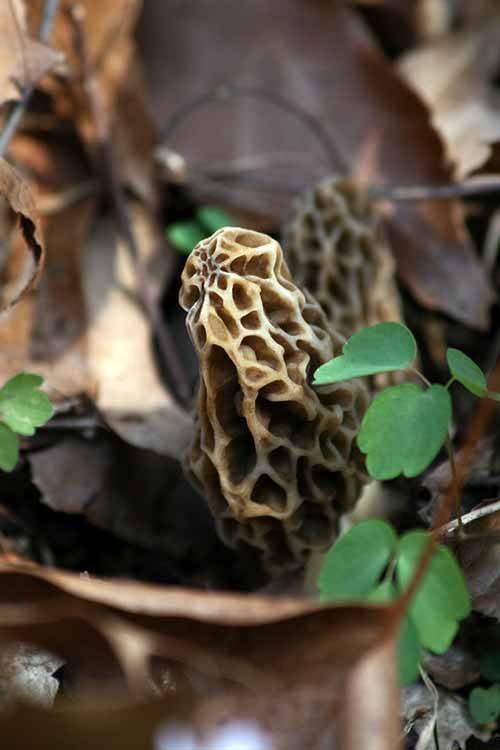
Ranging from yellow to brown and knobby, pitted and wavy – you could even say they look like gnomes themselves. When I first took a look at them, I thought, “Are these ugly mushrooms really the ones everyone goes crazy for?”
After foraging and eating a few morel dishes myself however, I was hooked.
And I can tell you from experience – after savoring this delicious fungi (that’s a harsh sounding word isn’t it?), you’ll associate its odd appearance forever with the wonderful, umami taste of the wild.
Foraging and Identifying
If you live in a temperate climate, it’s very likely that morels could be growing nearby. That includes North America, most of northern Asia, and Europe.
Further, you’ll want to target areas of undisturbed woodland – if you’re not near such places, you’ll have to make a bit of a trip. However, if you do have sites like this on your property – even nearby, in a city, state, or other public park – don’t overlook them.
A note on public areas, however: don’t be surprised if you find a fellow scavenger traipsing through the woods.
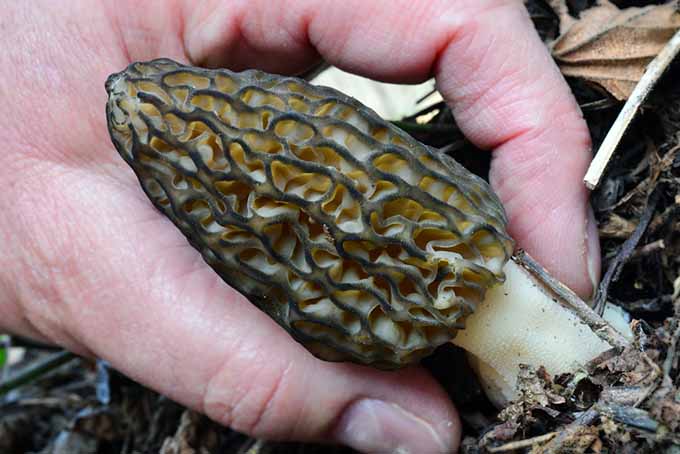
As I said, spring is a time when “morel fever” hits, and you might find that public areas are crawling with competition – or camaraderie, depending on how you look at it).
You might have the best luck in spots that are relatively remote. Of course, be sure to check with local wildlife regulations before tromping in certain wilderness areas – and make sure you have permission to access any private property.
May through June tends to be a hot time for wild morel production. But if the springtime warms earlier than usual, with plenty of rain and thunderstorms to boot, you might see them popping up a little earlier in April.
The farther south you go, temperate climates start off their season earlier on the spectrum, too.
Some tips:
- Look out especially for woodland slopes and ravines, particularly those leading to waterways like streams, brooks, and rivers. These are their favorite spots.
- While you may sometimes find morels growing close to disturbed areas (and be tempted to pick them), be careful to make sure they aren’t downhill from agricultural activity, or any areas where pesticides, herbicides, or other chemicals have been sprayed. Foraged items found too close to roads and that have been exposed to roadside exhaust should generally be avoided as well.
- Morels will almost always be found growing right out of the ground, and at the base of trees. They even have favorite trees they prefer – dying elms are #1 on their list.
- Other deciduous tree candidates: live elms, sycamores, ashes, old apple trees, cottonwoods, and tulip poplars are good ones to look out for.
- They like some evergreens too: especially firs, pines, and larches as well as Douglas firs (actually a type of hemlock).
What traits to look for, specifically?
Like I said, morels look quite a bit like some sort of funny garden gnome home. The cap is very unlike that of most grocery store mushrooms – it tends to be more oblong vertically, rather than horizontally, with lots of pit-like indentations all over.
There are many species, so they can be found in a variety of colors: from yellowish to tan, gray, or brown. The actual stem will almost always be lighter colored in contrast to the cap, and of a white or light tan color.
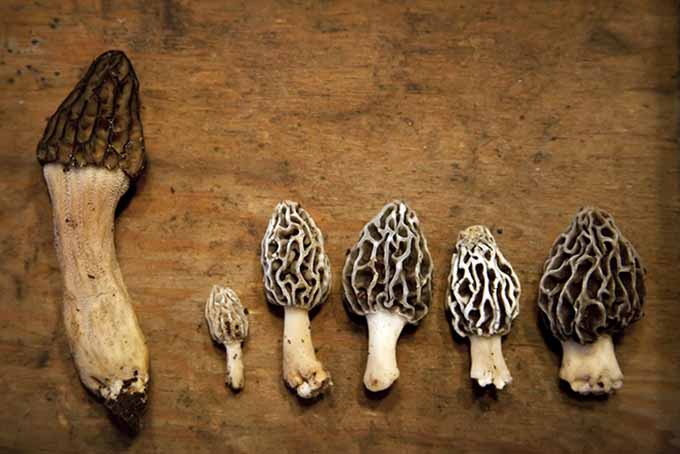
The real challenge you’ll have with morels: they are experts at camouflage, often growing completely unnoticed unless you’re really looking for them. One could be two inches away from your shoe, and you wouldn’t even know it.
At first, training your eye to really know what they look like and how to spot them might be difficult – but in time, as the foraging pros and mushroom experts say, you’ll know what to look for. It’ll become instinct with time!
How to harvest them, once you find them?
You can use your knife, or a deft hand, to cut or pull up the mushroom gently from the earth. Make sure to harvest the whole above-ground stem and cap, not just the cap.
Dangerous look-alikes?
Watch out for the false morel (genus Verpa). Most of them are quite distinct from morels, but some do bear a strong resemblance – and they are poisonous if eaten.
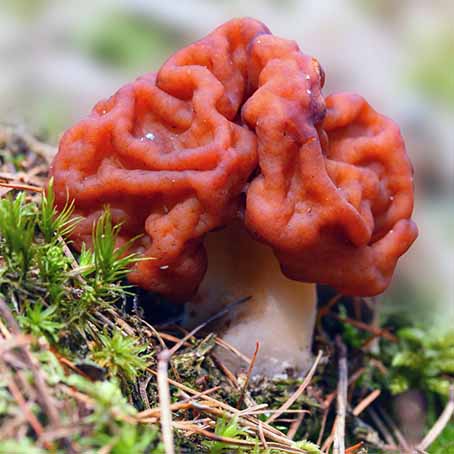
One easy way to tell them apart:
The false species have a more scrunched-up-looking cap, full of ridges and valleys (looking more like a brain) rather than having the actual pits that the true species has.
A test you can use that won’t fail:
Cut your harvested mushroom in half lengthwise. You’ll see that the cap is attached directly to a completely hollow stem for the entire length in true morels – while false morels have caps that separate from the stem at their bottom, and are not hollow.
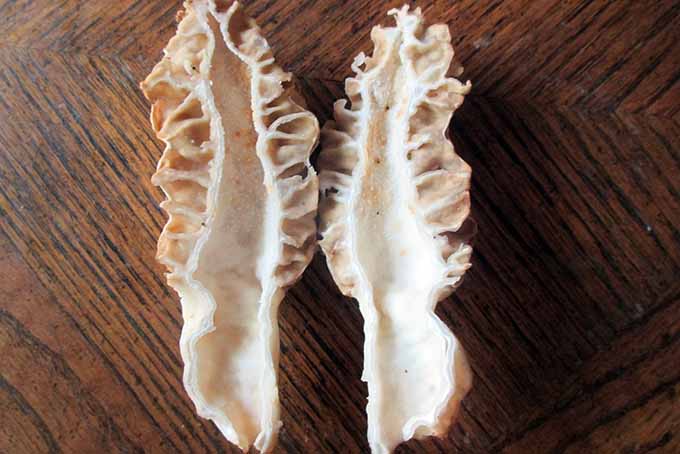
If you’re in need of more hunting and identification tips, be sure to check out Wilderness Today’s excellent morel guide.
Preparing
Always cook any morels you find. When raw, they contain a low-grade toxin that could make you sick – but cooking will remove this, at the advice of mycology expert Paul Stamets, the acclaimed author of Mycelium Running.
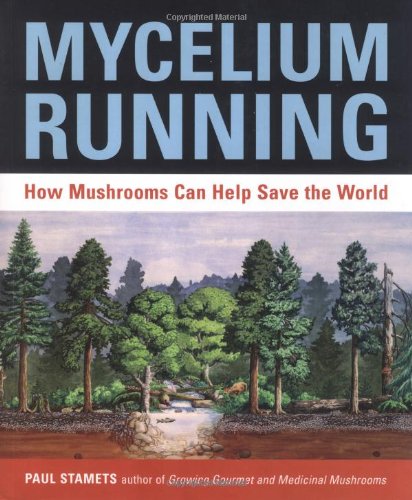
Check out this wonderful book for yourself, available now on Amazon.
It’s best to prepare them as fresh as possible, soon after you harvest. Waiting a couple weeks (at the most) after foraging them is acceptable, and it’s best to store them in the meantime in a paper bag in the fridge.
You can also dehydrate morels for long-term use, and preserve them for even long with the addition of oxygen absorber packets.
If your fungal find is dirty, simply remove the dirt with your fingers – it will usually only be an issue at the very bottom base of the stem. No need to wash them with water, as cooking will take care of any germ concerns for you!
Learn even more great techniques on how to clean and prep them!
Like your typical button mushroom, this wild variety is best when chopped up and lightly sauteed (or keep them whole if they’re small and bite-sized), bringing out an earthy yet savory flavor. You can also bake them straightaway into quiches, soufflés, egg bakes, and omelets. While they’re shape isn’t practical for any stuffed preparation, you have so many other options!
Lovers of this wild fare describe a flavor as if you were tasting a portobello – only if all the flavors were put under a magnifying glass for your taste buds!
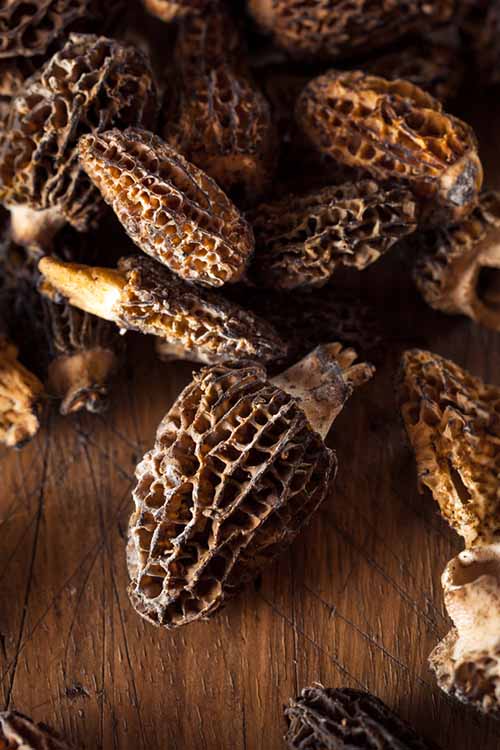
In simple fashion, cook them with a bit of butter or oil, and some salt and pepper to taste. Try pairing these with the following foods:
Protein:
- Ham
- Lamb
- Pork
- Eggs
Dairy:
- Crème fraiche
- Heavy cream
- Goat cheese
Fruits and Veggies:
- Asparagus
- Garlic
- Lemon
- Potatoes (especially new potatoes)
- Shallots
Herbs and Spices:
Miscellaneous:
- Pasta
- Soup stocks (especially chicken, vegetable, and mushroom)
- Vinegar and vinaigrettes

According to food experts Karen Page and Andrew Dornenburg (authors of The Flavor Bible, a top seller on Amazon), morels are excellent paired with some other wild-caught or harvested ingredients: think fiddlehead ferns, ramps, and black truffles!
Health and Healing Benefits
According to NutritionValue.org’s profile, morels are a significant food source of vitamin D. This is good news for vegetarians and vegans: most mushrooms are very high in this vitamin, typically only found in significant dietary amounts in meat, fish, or fortified foods – but these wild ones have plenty.
Other nutrients it contains: fiber, iron, protein, manganese, zinc, copper, and vitamins B3 (niacin), and B2 (riboflavin). As a truly nutritious food, it’s no slouch!
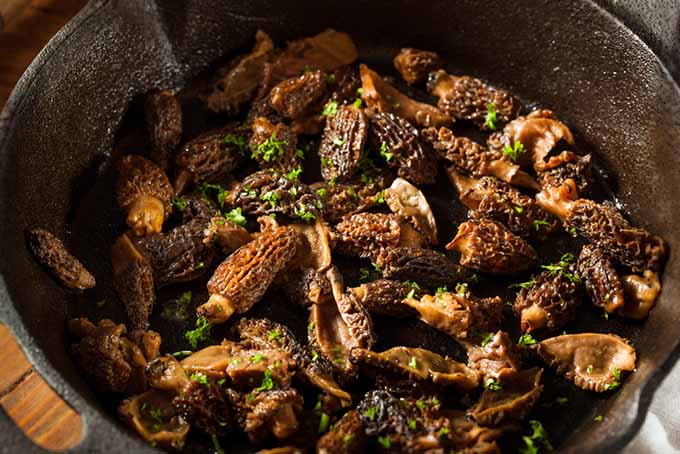
In some old medicinal traditions around the world, morels were considered nutritive and tonifying – that is, they were a food that was administered to help recover and strengthen the weak or ill.
In Traditional Chinese Medicine (TCM), an alternative practice still used today, they were used to strengthen the lungs, combat respiratory infections, and regulate digestive disorders.
There is some research today that shows promise for anti-cancer, antioxidant, and even immuno-modulating potential.
Chicken of the Woods
Whether you’re a veteran fan of morels, have just freshly caught “morel-fever,” or you want to know about other edible mushrooms in general – for all of you out there who have enjoyed the other gnomish fungi, it might excite you to go looking for chicken of the woods this spring, too.
From the genus Laetiporus, also commonly called sulphur shelf mushrooms (or just chicken mushrooms), it could surprise you how many folks get a real hankering for these foodie fungi – which reportedly taste just like chicken!
Foraging and Identifying
These are not to be confused with hen of the woods, also called maitakes. That particular variety is also an equally delicious foraged fare, but aren’t usually ready to pop until the fall – and they also look quite different.
A versatile fungus, it has been found in the wild all around the world. Spring is a great time to start scavenging, when the weather becomes warm in temperate climates.
One great thing about chicken of the woods: you can also find them throughout summer and into autumn, so long as the weather is warm.
In places with cold winters, you won’t find them during that season. Like most wild mushrooms, they go dormant.
So, where to get looking?
As with morels, you’ll want to scout the woodlands – but while those like to spring up right out of the ground, with this type you’ll want to scan the tree bark and sides of trees above the ground. That’s right: chicken of the woods grows right out of the trees themselves.
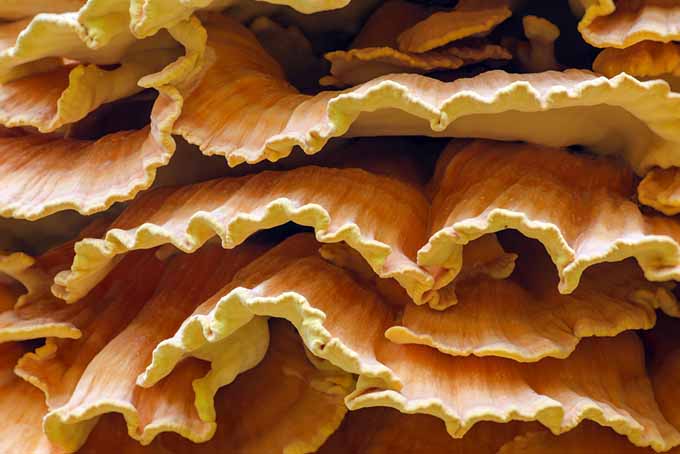
Some tips:
- Chicken of the woods absolutely loves to grow out of wounds in oak tree trunks. Scan this species of tree specifically.
- Don’t overlook a few other deciduous kinds it likes too: willows, chestnuts, even eucalyptus.
- In coniferous woods, you might find them growing on certain evergreen trees, and they don’t appear to show a strong preference for a certain species.
- Like morels, you’re most likely to find young flushes of these that are ready for harvest after a good rain or thunderstorm.
- You may see these fungi growing on trees near roadsides – again, be careful not to pick if they are near high-traffic road exhaust or chemical spray areas.
What traits to look out for specifically?
Compared to morels, which are notorious for blending right into the landscape, you’ll have a ball finding these.
That’s because they’re quite bright-colored, ranging from vivid orange to pink, or a sulphur-like yellow that stands out noticeably against the darker bark of a tree.
They also grow out of trees in layered clusters, in a shelf-like fashion. This is what gives them their other name, “sulphur shelf.”
In most specimens, you’ll notice that they have lots of stripes. This can make some of them very multi-colored, with alternating stripes of pink, orange, and yellow. The outside edges will almost always be much more vivid and brighter than the rest of its fruiting body.
If you look at the underside of a chicken of the woods cluster, its belly will either be a pale yellow or white, with pores running underneath instead of gills (unlike what you’ll see in other edible fungi like portobello or shiitakes).
How to harvest them, once you find them?
This is simple – and somewhat similar to how you’d harvest a morel. With a knife, just cut away the cluster flush with the tree bark, as close as you can get to retrieve as much delicious chicken of the woods as possible.
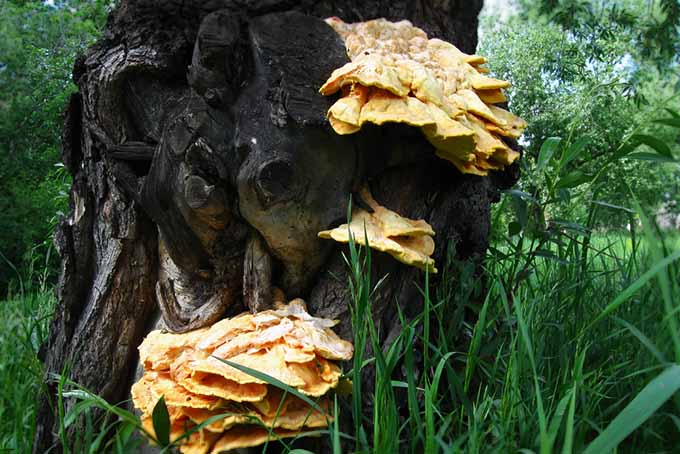
You can also pinch or pick away some clusters with your hands – the whole cluster should come away intact. Make sure to only harvest young, rubbery-feeling, and fresh-looking mushrooms. If it feels tough or brittle, the cluster might be too far gone to be edible.
In some cases, only parts of a young cluster (typically the centers) may have become toughened with time. Test them out gently with our fingers. If they feel tough, you can easily remove them with a knife.
Dangerous look-alikes?
Not only are chicken mushrooms easy to see and forage come spring, they also don’t have any dangerous look-alikes. Hooray!
There are other varieties out there that look like chicken of the woods, but they won’t hurt you. They are, however, nasty and inedible.
All that will happen most likely: you’d spit them right back out after you cook and eat them. Just make sure any fungi you harvest that match the above identifications taste good before you serve them!
Preparing
Chicken of the woods is considered a delicacy to many Americans, and is a popular culinary favorite in some parts of Europe as well – most notably Germany.
Most who have cooking experience with this suggest slicing it up into nice long strips, like you would with large shiitakes (and chicken of the woods can get quite big).
Otherwise, you can dice it up like any other mushroom, an easy task due to its rubbery nature. Want to preserve it? It works well to either pickle, freeze, or dehydrate this wild food. For the short term, you can brush away any bark that may still be attached, and store it in a paper bag in the fridge.
Sautéing and frying up this tasty fungus, like you would any other, is the classic way to enjoy it. Since so many people think it tastes just like chicken, throw it in dishes that call for chicken – with vegetables, herbs, spices, you name it.
For vegetarians and vegans that miss the taste of chicken, foraging chicken of the woods can make up for this with its own delights. Try cooking it in combination with some of the following ingredients:
Protein:
- Bacon
- Chicken (of course!)
Dairy:
- Cheese (Asiago, Parmesan)
- Crème fraiche
Veggies and Fruits:
- Chili peppers
- Garlic
- Lemons
- Onions
- Potatoes
- Tomatoes
Herbs and Spices:
- Cardamom
- Cinnamon
- Coriander
- Curry Powder
- Ginger
- Mustard
Miscellaneous:
- Beer
- Coconut milk
- Honey
- Soup stocks (especially chicken)
- Wine
Health and Healing Benefits
Not a whole lot of information is available describing the chicken mushroom’s nutritive or health benefits. MyFitnessPal reports that it could be a significant source of vitamin C, protein, and fiber – but all the same, this requires more study.
Traditional use in medicine or healing is lacking, too – however, studies on the fungus demonstrate very strong antimicrobial and antioxidant capabilities.
This could make it somewhat supportive to digestive illnesses, and a possible topical wound healer.
Oysters
Oyster mushrooms (Pleurotus ostreatus) are a gourmet darling in the world of cooking, being cultivated for fancy dishes all over the world. While they are wild fare, you can often find them on grocery store shelves too.
Like chicken of the woods, however, you can also find this treasure around the globe in woods during springtime – particularly after the first heavy rains in late April and May. Wait until the rains of autumn, too, and you’ll stumble upon it then as well.
Why are they called oysters? Like the chicken mushroom, its name has a lot to do with its taste: and many say that oysters taste quite a bit like fine delicate seafood, particularly oysters.
Foraging and Identifying
Fungal aficionados will tie on their hiking boots and go looking for this gorgeous fungi as soon as weather is warm and rainy.

Back to the Roots Organic Mushroom Farm
Other fans may go a different route: growing their own. If you’re interested in tinkering with that, I’d recommend you check out some easy starting kits – like the one shown above from Back to the Roots (available on Amazon).
Otherwise, if you want to join in on the foraging fun, check out similar areas that you would for chicken of the woods: the woodlands!
Some tips:
- Oysters prefer hardwood trees, so be sure to explore deciduous woods.
- Like chicken of the woods, this wild variety grows out of wounds in the sides of trees – unfolding into delicate, beautiful clusters. Be sure to scan tree trunks.
- The best times to look for them are the week following a heavy rain, any time from late spring through early fall.
- Again, if these are seen growing on trees near high traffic roadsides or in areas that may have been chemically contaminated, do not pick and eat them.
What traits to look out for specifically?
Oysters grow in a shelf-like fashion, much like chicken of the woods, though you could say their patterns strike the eye in a softer, much gentler way.
While the chicken type are known for bright colors ranging from orange to pink, oysters put on a different show as they are more fragile and multi-layered, emerging intricately and delicately from the bark.
When you find a large, ornate cluster, you might want to take a picture! Oysters sure are pretty, but you’ll have a harder time noticing them with their less obvious colors: ranging from gray and grayish-blue to brown, white, yellow, or tan.
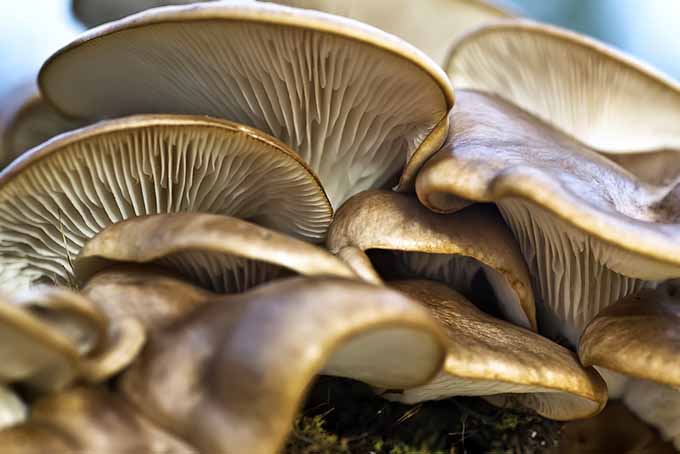
They are almost always a lighter color than the tree bark from which they grow, however. Oysters have rounder caps, and elegant gills on their undersides that travel all the way down to the base of their delicate stems – a trademark characteristic.
How to harvest them, once you find them?
Use a knife or pinch the base of the stem in your fingers to gently remove the cluster from the side of the tree (both caps and stems), just like with chicken of the woods.
You should remove it in such a way that the whole cluster comes away intact – though if a stray mushroom in the group separates, this is okay and completely normal.
However, you should expect to be much gentler with oysters than most other wild edible fungi. They are incredibly delicate, and can bruise or fall apart easily!
Make sure to get them to a safe, dry place quickly so they don’t get jostled around.
Dangerous look-alikes?
The only fallback to foraging oysters: there are quite a few poisonous imposters, practically anywhere in the world where they may grow. For this reason, you must be careful.
Here are a few markers to help you determine if it is indeed an oyster:
1. Is it growing from a hardwood tree? You will only very occasionally see oysters growing on softwoods, such as a poplar or rotting conifer.
2. Is it completely smooth? It should be. Is it pigmented in some way, with patches of color? Oysters are completely uniform in color.
These wild edibles should also be completely free of anything that looks like fuzz or hairs, being a completely smooth variety.
3. One telltale sign of oyster positive I.D. are its underside gills, which should run all the way from the edge of its caps, and down the stems to its very base.
4. Another trademark: give your specimen a sniff. Does it have a faint licorice or anise-like aroma? You probably have oysters on your hands – but if you’re unsure about any of this, please refer to the guidance of a seasoned expert.
Preparing
Popular the world over, cooking this wild fare will have you feeling like a professional chef in no time! Like most type of fungi, including morels and chicken of the woods, oysters are best when they are sliced, diced, or even torn up and then sauteed.
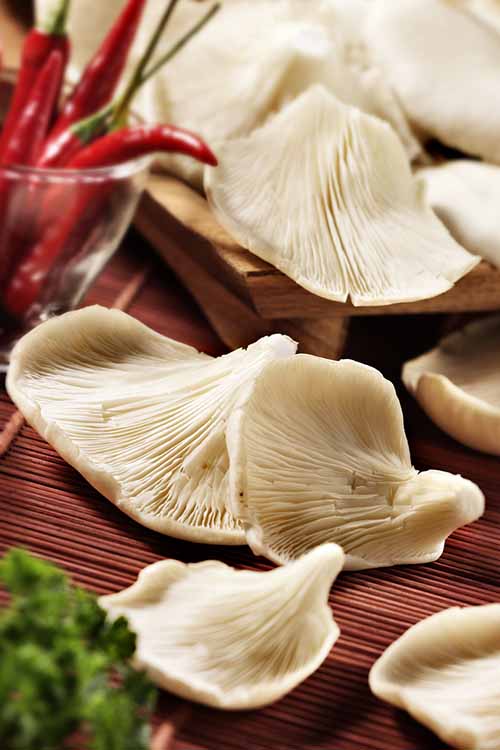
Since they are so delicate whether off or on heat, you really need only to fry them very lightly and gently on low, to bring out their superb texture and flavor.
It’s difficult to preserve them well in any way – so use them up quick! Here are some excellent cooking combinations with oysters:
Protein:
- Seafood (especially delicate shellfish like oysters, scallops, clams)
Dairy:
- Butter
- Cream
- Sour cream
Veggies:
- Beets
- Potatoes
- Spinach
Herbs and Spices:
Miscellaneous:
- Aioli
- Capers
- Hollandaise
- Soup stocks (especially chicken, clam, or fish)
- Wine (dry)
Health and Healing Benefits
The oyster variety has a reputation in traditional healing as an immune-boosting and tonifying food. This is most likely due to its high quality nutritional content: being a significant source of iron, protein, amino acids, B vitamins, and potassium, as recorded by NutritionData.com.
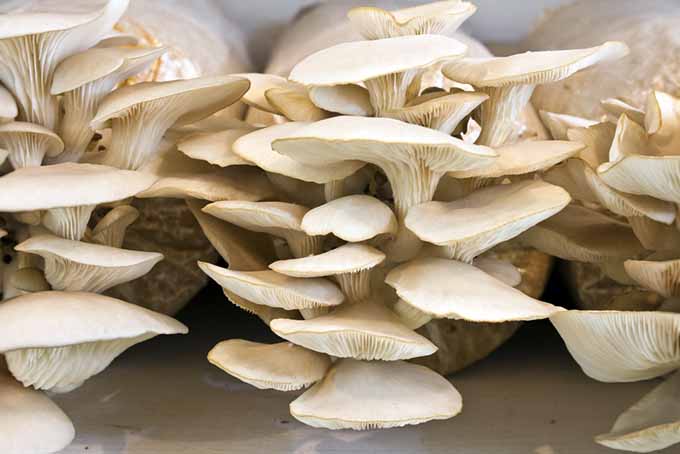
Today, oysters have been noted for their potential in lowering cholesterol – a recent trial revealed that a diet including regular consumption of the fungi helped to lower cholesterol levels in humans.
The Joys of Foraging Fungi
With what you’ve learned in this article, do you think you’re ready to head to the woods and get foraging?
I can tell you from my own experience: the world of mushrooms can be a bit daunting at first, but the rewards are delicious, healthy, and well worth it. However, if you are unsure or unconfident about finding wild foods: leave it to the experts, or even better, invite one along during your forage!
Plus, it’s a bunch of fun to take part in the morel-gathering season, trek the wild with others, add these delights to your cooking – and to also keep your eye out for other spring treasures like oysters or chicken of the woods.
Intrigued by the thought of foraging, or do you want to learn more about how to become an expert at mushroom identification (and more)? I would recommend reading more expert literature on the subject.
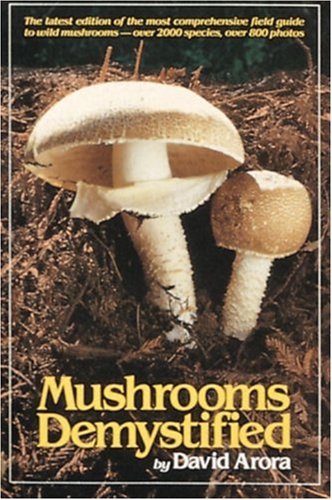
I particularly encourage checking out the famous guide by expert mycologist David Arora, Mushrooms Demystified, available on Amazon.
What are your experiences with morels: foraging them, cooking with them, eating them, or even how they have impacted your life and health for the better?
That goes for tasty oysters and chicken of the woods, too! Talk to us, and comment below – we’d love to hear from you.
The staff at Foodal are not medical professionals and this article should not be construed as medical advice. Foodal and Ask the Experts, LLC assume no liability for the use or misuse of the material presented above. Always consult with a medical professional before changing your diet, or using supplements or manufactured or natural medications.
Photos: Shutterstock.
About Adrian White
Adrian White is a certified herbalist, organic farmer, and health/food writer and expert. She aims to bridge the world of natural, holistic health and nutrition to the realm of organic foods, herbalism, gardening, and sustainability - or "Food as Medicine" - throughout her writing.






Thank you for this guide and the cooking suggestions which I shall have to try out since I love mushrooms.
I’ll confess I’m more likely to take your guide with me round the supermarket than actually go foraging in woodlands. It’s not just the mud, but we have had a few too many incidences of people eating the wrong type around here (apparently Destroying Angel looks like a type commonly eaten in abroad, but is very toxic), so I would rather avoid the risk.
For anyone braver than me though, there’s a site: Michegan Morels, which shows a comparison of false and true morels in pictures.
Thank you for reading, Katie 🙂 I love mushrooms just as much as you, but agree with you – if you don’t feel confident to head to the woodlands, you’re making a smart decision. Mistakes do happen, and they’re not worth it. Fortunately with morels, there are very easy ways to identify them safely once you learn them! Chicken of the woods is an easy start, too, since it has a unique appearance. I highly recommend going out with an expert and guide, and having them show you the ropes. It is worth it.
Interesting article. Foraging, however, is not for me. I have seen more than one expert make mistakes and get very sick. Plus, I’m the only one in my home that even likes mushrooms.
Hi nytegeek – thanks for reading! Some wild fungi do have strong lookalikes that are dangerous, and experts do make mistakes – I understand your reserve. What that basically means though, nytegeek, is that you are a smart guy. The folks who have to worry about poisoning are those who think they could be experts after reading one or two online articles, and head out forthwith equipped mostly with overconfidence. Clearly, this is not your case – and your skepticism, ironically, is a sign that you have enough caution and a strong head on your shoulders to most likely not make those same mistakes.
Thank you so much for this post! I have been living in the Czech Republic for almost 2 years now and during Spring time, it seems like everyone is an expert at picking the right wild mushrooms. I have always wanted to know how to properly choose between edible and poisonous mushrooms, and now I can safely go into the woods knowing I will make the right choice. Also, I can now pick which mushrooms to use based on what I have in my pantry. Thank you! 🙂
Hi Carolina! Thank you for reading and following. I’m glad this article gave you a little more confidence to get out there and look for these edible fungi so many folks around the world enjoy.
While this article has some pretty great tips from my experience, nothing beats going out your first time looking with someone who is a seasoned expert who can show you what you need to know. It’s also a much safer way to go about it, as mistakes can be dangerous. No doubt, the folks you know in the Czech Republic know the right ones to pick by starting out the same way – and it’s probably a big part of local food culture there, too, that they’ve learned over the years. If you’re interested in learning, maybe ask one of your expert friends (or more) to accompany you. I know me and my friends have a lot of fun with foraging that way!
I really just started eating mushrooms within the last two years. They’re pretty good. But when you talk about foraging I’m glad you put up disclaimers because i have always heard crazy stories of people eating various fungi and suffering crazy consequences.
Hi Brandiesha – thanks for reading 🙂 You do have to be very careful, and reading just a little bit then jumping out into the woods by no means protects you from mistakes. It’s good that people talk about the chances of getting hurt (as well as mortality) because that keeps people on their toes and cautious when getting into this hobby. The nice thing to realize, though – a good two thirds or more of statistical reported poisonings are non-fatal, many of them sometimes even showing no symptoms. The most likely victims of poisoning? Children and dogs! If you’re not a child or a dog and you are a responsible adult, try going out with an expert to develop confidence. Hundreds of thousands of people savor morel and other edible fungi seasons around the world – equipped with the right knowledge and experience, so can anyone else (safely).
I’m from Michigan and Morels are really big here in the spring. People go out scouting them in droves, often bragging later about how many they find. I’ve never really gone out looking for mushrooms but since that type are about the only kind that I actually recognize, I think I would have little trouble identifying one if I saw it. Maybe someday I’ll motivate enough to go out looking.
Hi Kristie 🙂 Thanks for reading. Midwest morel fever, am I right? We’ve got the same thing going on out here in Iowa.
I’d say that’s one of the best ways you can learn how to hunt for them – and I owe a good chunk of my own experience partially to just getting out there with locals, talking about them, learning from them, and looking for them. It’s part of culture, in a way. If you have friends who go out looking for them, join them! You could learn so much, just like I did, and even have a great time.
Thank you for the detailed article. I personally have only had morals and had no clue about the other types out there. I have found personally that they only grow under low lying trees like evergreens and bushes. I remember the first time I had them, my parents were so excited when they found some in our back yard and I have to say I’m not a big fan at all. I like mushrooms but i just don’t care for them.
That’s too bad you’re not such a huge fan, rmd. Some people just don’t like edible fungi, cultivated or wild – but then again, I have seen some people convert quickly when you sautee them with a bit of butter, sometimes even lime juice. From the sounds of it, you must live on the West Coast or a temperate coniferous region. I hope your mind is not closed off forever! Thanks for reading 🙂
Wow! Your blog is chock-full of information, ideas and inspiration! Thank you, Adrian!
Say hi to Pete, Cody and Kerby for me! Will, too! : )
Kathy – I will certainly pass the message along, I’m sure I will see them soon! And thanks for reading! Much love and hugs to you and yours (wherever you are at this point in the States)!
I love mushrooms, but I’m used to the kind you find in the grocery store, however, I wouldn’t mind going out with an expert and a group of friends to find some. Being out in the woods exploring, and finding mushrooms sounds absolutely fun!
It really is! And when you’re with someone who’s done if for years and years, it takes away from the uncertainty of misidentifying or making mistakes. The more you go each spring, the more confident you’ll be that you can track down the tastiest ones on your own. But nothing beats having a little scavenging party with friends 🙂
A great compilation of wild mushroom tips for beginners. I was wandering what the minimum cooking intensity was for morels…I guess sautee was the reasonable explanation after all.
Now that lately there’s a trend to foraging mushrooms in the forests people with little fungal knowledge should also be careful about foraging mushrooms that might not be edible in their side of the hemisphere: there is an edible species of Amanita fungi that grows in Asian countries, but since it looks almost identical to its western counterpart Amanita muscaria, there have been many cases where very foraging-experienced people poisoned themselves unaware that the eastern from the western species are different.
Many cultures local to forests tend to avoid using ambiguous mushrooms in their cuisine altogether, once a friend of mine told me that where he comes from they avoid chicken of the forest altogether because the inedible lookalike versions were overwhelmingly more frequent to find than the real thing. So to people traveling across the globe it’s good to find local mushroom enthusiasts to ask for this kind of information.
Also the nutritional value of a mushroom can often be detected in their taste. For example portobellos which are high in minerals, tend to leave a strong metallic aftertaste, and more protein rich mushrooms like morels tend to have a more umami taste.
Thank you very much for your comment, Mansa! I’ve seen morels be either sauteed or baked, in my experience; maybe a little bit longer than a portobello mushroom, but less than a shiitake.
That’s very interesting that there is a non-poisonous kind of red and white amanita out in Asia. People do need to be careful, I definitely agree – and my motto on foraging tends to be “you can’t know enough,” especially when you’re getting more “out there” and foraging less common edibles. Fortunately for morels, looking for them is much safer in comparison to foraging for amanitas! It’s a folk pastime in spring out here where I live in Iowa.
Interesting too that chicken of the woods in some parts of the world has a lot of inedible lookalikes more common than others. Out here, there are hardly any, especially with the edible being bright orange and striped (anything looking nearly the same is usually just brown or tan).
I did not know that little bit on mushroom nutrition, Mansa. Thank you!
Great post and amazing pictures to help identify. I am sorry to say I do not have the confidence to do this. I would be paranoid about either ending up on LSD, or else in the emergency room. I have no idea the ration of poisonous mushrooms to edible ones, but it is a bit like berries… if I am not 100% sure that berry is a blueberry or a raspberry, I am not going to eat it.
Azrile, thank you for reading! If you don’t have the confidence to forage, then don’t. A better alternative though: go out with somebody who has done it many times, and you might become more accustomed to the idea that some wild foods can be comfortably and safely identified and harvested if you are informed, knowledgeable, and not OVER-confident.
If it makes you feel any better: there is no way you could end up on LSD eating a mushroom. LSD is predominantly man-made chemical created in a lab, and it does not occur in nature (except in similar form in a few species of grain called ergot). Fungi contain different psychotropic chemicals than LSD, and the ones that do tend to look and grow quite different than the ones in this article. I hope your fears are allayed!
I used to go hunting for coral mushrooms in the woods on a friend’s property. It was as enjoyable finding them as it was eating them. We would find them in various colors but I think they all tasted the same. After rinsing them off, we would dip them in egg and then flour before deep frying them in oil. They were a very delicious treat.
This is always something that I have been curious about. I do not really think that I am all of the sudden going to start foraging for mushrooms or anything, and all I can picture is myself out there for ten hours, covered in mud with nothing to show for it, but it is interesting nonetheless. I like to try all sorts of mushrooms and see what flavors they have and how they differ, so this is really intriguing. Maybe one day I will try it, but for now learning about it is good enough for me, so thank you.
Awesome, lots of info here! My fiance and I are wanting to go mushroom hunting soon. We always buy them off of trusted family members who do the mushroom hunting and they are pricey! About $15 -$25 a pound depending on who you get them from. I would love to save that money and also know how to pick my own.